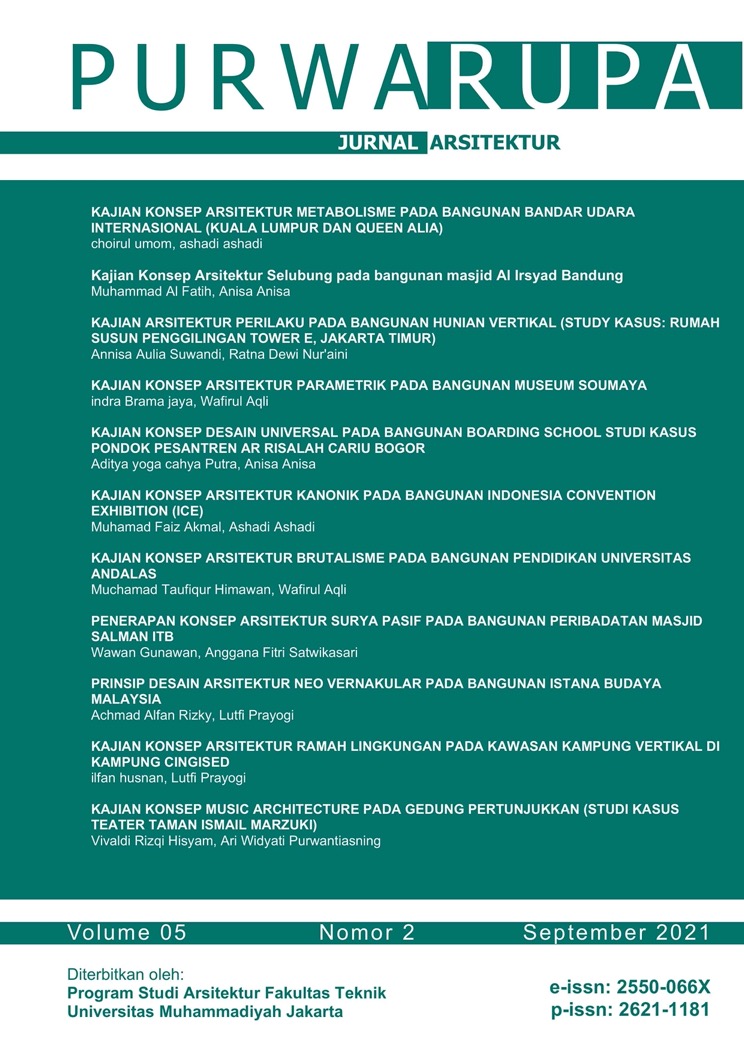KAJIAN KONSEP MUSIC ARCHITECTURE PADA GEDUNG PERTUNJUKKAN (STUDI KASUS TEATER TAMAN ISMAIL MARZUKI)
DOI:
https://doi.org/10.24853/purwarupa.5.2.79-86Abstract
ABSTRAK. Kajian ini akan membahas penerapan konsep Music Architecture pada gedung pertunjukan. Hal yang melatarbelakangi pentingnya kajian ini karena kondisi permusikan di Indonesia sudah semakin pesat namun kurangnya bangunan pertunjukan sebagai wadah konser musik untuk para musisi. Permasalahan dari penelitian ini adalah penerapan desain gedung pertunjukan yang terkait dengan musik dan arsitektur. Sedangkan tujuan dari penilian ini merupakan keterkaitan dan penerapan music architecture pada gedung pertunjukan sesuai dengan studi kasus yang sudah diteliti. Studi kasus kali ini merupakan Teater Jakarta Taman Ismail Marzuki. Metode penelitian yang digunakan peneliti adalah deskriptif kualitatif, dengan menganalisis konsep music architecture pada studi kasus gedung pertunjukan. Kata Kunci: musik, arsitektur, gedung, relasi ABSTRACT. This study will discuss the application of the concept of Music Architecture in the performance building. This is behind the importance of this study because the condition of music in Indonesia has been increasingly rapid but the lack of performance buildings as a forum for music concerts for musicians. The problem of this research is the application of performance building design related to music and architecture. While the purpose of this research is the linkage and application of music architecture in the performance building in accordance with the case studies that have been studied. This case study is the Jakarta Theater Taman Ismail Marzuki. The research method used by researchers is qualitative descriptive, by analyzing the concept of music architecture in performance building case studies. Keywords: music, architecture, building, relationshipsReferences
Struktur Lagu Fantasia On Themes From La Traviata Karya Francisco Tarrega. Yogyakarta: Skripsi Sarjana Jurusan Pendidikan Seni Musik Fakultas Bahasa Dan Seni Universitas Negeri Yogyakarta.
Farizan, Darari Taufiq. (2016). Perancangan Concert Hall Di Kota Malang Dengan Pendekatan Assosiation With Other Art Muic approach. Surakarta: Tugas Akhir Program Studi Arsitektur Fakultas Teknik Universitas Muhammadiyah Surakarta.
Fitrianto, Diky. (2016). Solo Baru Modern Musik Concert Hall Penekanan Pada Arsitektur Kontemporer. Surakarta: Tugas Akhir Program Studi Arsitektur Fakultas Teknik Universitas Muhammadiyah Surakarta.
Indriani, Natasya Arry. (2003). Kajian Awal Interpretasi Ruang Dalam Musik Dan Arsitektur Dilihat Dari Pembentukan Karakter Ruang. Depok: Skripsi Sarjana Fakultas Teknik Universitas Indonesia.
Nindya, Stella. (2012). Keterkaitan Musik Dengan Arsitektur. Depok: Skripsi Sarjana, Fakultas Teknik Universitas Indonesia.
Downloads
Published
How to Cite
Issue
Section
License
COPYRIGHT POLICY
The author(s) of an article published in the Jurnal Teknologi retains ownership of the intellectual property rights in work (s).
PUBLISHING RIGHTS
The author(s) of an article published in the Jurnal Teknologi have unrestricted publication rights. The authors give the Jurnal Teknologi the right to publish the article and designate the Faculty of Engineering Universitas Muhammadiyah Jakarta Publishing as the original publisher of the article.
LICENSING POLICY
Journal of Mechanical Engineering and Sciences is an open-access journal that follows the Creative Commons Non-Commercial 4.0 International License (CC BY-NC 4.0), which states that:

Under this license, the reusers must give appropriate credit, provide a link to the license, and indicate if changes were made. Users may do so in any reasonable manner, but not in any way that suggests the licensor endorses users or their use.
Please take the time to read the whole license agreement (https://creativecommons.org/licenses/by-nc/4.0/). As long as reusers follow the license conditions, the owner cannot withdraw these freedoms. The following components are included under this license:
 Attribution: Users must provide appropriate attribution, including a link to the license, and indicate whether or not they made any modifications. Users are free to do so reasonably, but not in a manner that indicates the licensee approves of their usage.
Attribution: Users must provide appropriate attribution, including a link to the license, and indicate whether or not they made any modifications. Users are free to do so reasonably, but not in a manner that indicates the licensee approves of their usage.
 NonCommercial: Users may not use the material for commercial purposes.
NonCommercial: Users may not use the material for commercial purposes.

